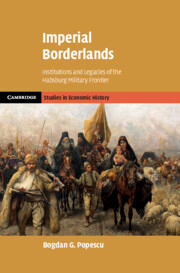Book contents
- Imperial Borderlands
- Cambridge Studies in Economic History - Second Series
- Imperial Borderlands
- Copyright page
- Contents
- Figures
- Tables
- Acknowledgments
- 1 Historical States, Imperialism, and Development
- 2 Imperialism and Extractive Institutions: A Theoretical Framework
- 3 The Habsburg Military Frontier
- 4 Military Colonialism and Economic Development
- 5 Colonial Institutions and Social Norms
- 6 Lasting Legacies Political Attitudes and Social Capital
- 7 Beyond the Habsburgs
- Epilogue
- Book part
- Primary Sources
- Index
3 - The Habsburg Military Frontier
Published online by Cambridge University Press: 09 November 2023
- Imperial Borderlands
- Cambridge Studies in Economic History - Second Series
- Imperial Borderlands
- Copyright page
- Contents
- Figures
- Tables
- Acknowledgments
- 1 Historical States, Imperialism, and Development
- 2 Imperialism and Extractive Institutions: A Theoretical Framework
- 3 The Habsburg Military Frontier
- 4 Military Colonialism and Economic Development
- 5 Colonial Institutions and Social Norms
- 6 Lasting Legacies Political Attitudes and Social Capital
- 7 Beyond the Habsburgs
- Epilogue
- Book part
- Primary Sources
- Index
Summary
Chapter 3 describes the historical context of the empirical investigations developed in the subsequent chapters. It discusses the emergence, development, and the end of military colonialism in the southern borderlands of the Habsburg Empire. The military frontier was a cost-effective institution to protect both the Habsburg state and Christian Europe against the expansion of the Ottoman Empire. After 1463, the Habsburg regions of Carniola, Carinthia, and Styria were subject to yearly Ottoman attacks with the local estates being hardest hit. The chapter outlines the main political tensions between the Habsburg emperors, local elites, and peasant communities that emerged in the early stages of the adoption of military colonialism through a rich documentation of historical conditions. Some of these tensions we can trace back to the extended negotiations between Ferdinand I (1503-1564) and the local landed estates, who became financially responsible for the maintenance of the military area. The people inhabiting the newly created colonies were freed from serfdom and given land in exchange for military service. The chapter illustrates how military colonialism evolved over time, and describe the types of policies that the imperial authorities adopted to ensure the longevity of this institution in different regional contexts.
- Type
- Chapter
- Information
- Imperial BorderlandsInstitutions and Legacies of the Habsburg Military Frontier, pp. 66 - 99Publisher: Cambridge University PressPrint publication year: 2023



